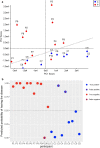A SWATH-MS analysis of Myalgic Encephalomyelitis/Chronic Fatigue Syndrome peripheral blood mononuclear cell proteomes reveals mitochondrial dysfunction
- PMID: 32972442
- PMCID: PMC7512220
- DOI: 10.1186/s12967-020-02533-3
A SWATH-MS analysis of Myalgic Encephalomyelitis/Chronic Fatigue Syndrome peripheral blood mononuclear cell proteomes reveals mitochondrial dysfunction
Abstract
Background: Myalgic Encephalomyelitis/Chronic Fatigue Syndrome (ME/CFS) is a serious and complex physical illness that affects all body systems with a multiplicity of symptoms, but key hallmarks of the disease are pervasive fatigue and 'post-exertional malaise', exacerbation after physical and/or mental activity of the intrinsic fatigue and other symptoms that can be highly debilitating and last from days to months. Although the disease can vary widely between individuals, common symptoms also include pain, cognitive deficits, sleep dysfunction, as well as immune, neurological and autonomic symptoms. Typically, it is a very isolating illness socially, carrying a stigma because of the lack of understanding of the cause and pathophysiology.
Methods: To gain insight into the pathophysiology of ME/CFS, we examined the proteomes of peripheral blood mononuclear cells (PBMCs) by SWATH-MS analysis in a small well-characterised group of patients and matched controls. A principal component analysis (PCA) was used to stratify groups based on protein abundance patterns, which clearly segregated the majority of the ME/CFS patients (9/11) from the controls. This majority subgroup of ME/CFS patients was then further compared to the control group.
Results: A total of 60 proteins in the ME/CFS patients were differentially expressed (P < 0.01, Log10 (Fold Change) > 0.2 and < -0.2). Comparison of the PCA selected subgroup of ME/CFS patients (9/11) with controls increased the number of proteins differentially expressed to 99. Of particular relevance to the core symptoms of fatigue and post-exertional malaise experienced in ME/CFS, a proportion of the identified proteins in the ME/CFS groups were involved in mitochondrial function, oxidative phosphorylation, electron transport chain complexes, and redox regulation. A significant number were also involved in previously implicated disturbances in ME/CFS, such as the immune inflammatory response, DNA methylation, apoptosis and proteasome activation.
Conclusions: The results from this study support a model of deficient ATP production in ME/CFS, compensated for by upregulation of immediate pathways upstream of Complex V that would suggest an elevation of oxidative stress. This study and others have found evidence of a distinct pathology in ME/CFS that holds promise for developing diagnostic biomarkers.
Keywords: Chronic fatigue syndrome; Diagnostic biomarker; Inflammation and immunity; Metabolism; Mitochondria; Myalgic encephalomyelitis; Oxidative phosphorylation; Oxidative stress; Reactive oxygen species.
Conflict of interest statement
The authors declare they have no competing interests.
Figures




References
-
- IOM (Institute of Medicine). Beyond Myalgic Encephalomyelitis/Chronic Fatigue Syndrome: Redefining an Illness. Washington (DC): Natl Acad Press (US); 2015. - PubMed
-
- Carruthers BM, van de Sande MI, de Meirleir KL, Klimas NG, Broderick G, Mitchell T, Staines D, Powles ACP, Speight N, Vallings R, Bateman L, Baumgarten-Austrheim B, Bell DS, Carlo-Stella N, Chia J, Darragh A, Jo D, Lewis D, Light AR, Marshall-Gradisnik S, Mena I, Mikovits JA, Miwa K, Murovska M, Pall ML, Stevens S. Myalgic encephalomyelitis: International Consensus Criteria. J Intern Med. 2011;270:327–338. doi: 10.1111/j.1365-2796.2011.02428.x. - DOI - PMC - PubMed
Publication types
MeSH terms
Substances
LinkOut - more resources
Full Text Sources
Other Literature Sources
Medical

